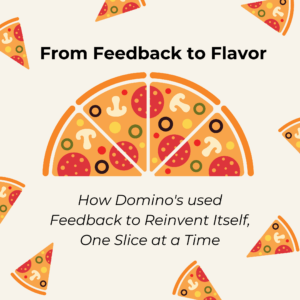
Thursday, February 15, 2024
 In 2009, Dominos underwent one of the most famous and successful ad campaigns in the 21st century. But it wasn’t just an ad campaign; it was a transformation of their very identity. Dominos looked in the mirror, saw they needed to change, and acted on it. The subsequent years of growth and success were a direct result of this initiative.
In 2009, Dominos underwent one of the most famous and successful ad campaigns in the 21st century. But it wasn’t just an ad campaign; it was a transformation of their very identity. Dominos looked in the mirror, saw they needed to change, and acted on it. The subsequent years of growth and success were a direct result of this initiative.
For those of you who don’t remember, in the years leading up to this change, Dominos was not exactly lauded as a provider of premier cuisine. Dominos was the last resort of last resorts. Kept in business largely by intoxicated college students and desperate insomniacs, Dominos occupied a space in public opinion slightly above uncooked ramen and slightly below a plain, folded-up tortilla. The sauce tasted like ketchup, and the crust tasted like cardboard.
That last sentence was not my own opinion; they are verbatim comments from customers, and those two statements were broadcast across the United States to everyone who would listen. Because instead of burying their heads in the dough, Domino’s did something radical: they admitted they were “sucking.” In what was dubbed as the “We’re Sorry for Sucking” campaign, Dominos found some of the most biting criticism about their product, publicized it, apologized, and promised to act.
This wasn’t your typical PR spin; it was a raw, honest apology. Domino’s aired commercials showcasing their subpar pizzas, invited customers to roast them on social media, and came clean on methods they had been using to make their pizza look more appetizing than it was. It was a gamble, a public flaying, but it was also a masterclass in the power of gathering, and acting on, feedback.
So, what made this campaign so successful? Here are a few key takeaways:
Embrace your flaws: Denial is a recipe for disaster. By acknowledging and accepting its issues, Dominos was able to clearly see what needed to be done and organize a plan of action.
Listen to your customers: They didn’t just hear the complaints; they actively sought them out, creating avenues for customers to voice their frustrations.
Show you’re listening: By showing customers that they were listening to and acting on their feedback, Dominos conveyed that they valued their customers and wanted to meet their needs.
Act on the feedback: Domino’s didn’t just apologize; they used the feedback to overhaul their recipes, improve their service, and invest in technology.
Be transparent and authentic: The campaign wasn’t slick or polished; it was honest and relatable. By being humble and willing to change, Domino’s established trust with its customer base.
The results were nothing short of spectacular. On December 31st, 2009, Domino’s stock price was $6.87. As I am writing this in early 2024, Domino’s stock price is $426.77. That represents an increase of over 6200%. In that same time, Domino’s market share went from 9 – 15%. There are a lot of factors that drive financial performance, so this growth cannot be attributed entirely to the “We’re Sorry for Sucking Campaign.” However, in the time leading up to it, Domino’s was struggling — in 2008 Domino’s same-store sales growth declined for the first time ever, and that decline continued in 2009, along with net income, and customer satisfaction. It is safe to say that that trend was handily reversed, and the “We’re Sorry for Sucking” campaign marked a pivotal moment in Domino’s history.
So, the next time you’re looking to improve your performance, or that of your business, remember Domino’s. Search out feedback and don’t shy away from it. Embrace it. Use it to improve, to grow, and to forge a stronger connection with your customers. Because sometimes, admitting you’re “sucking” can be the first step to soaring.